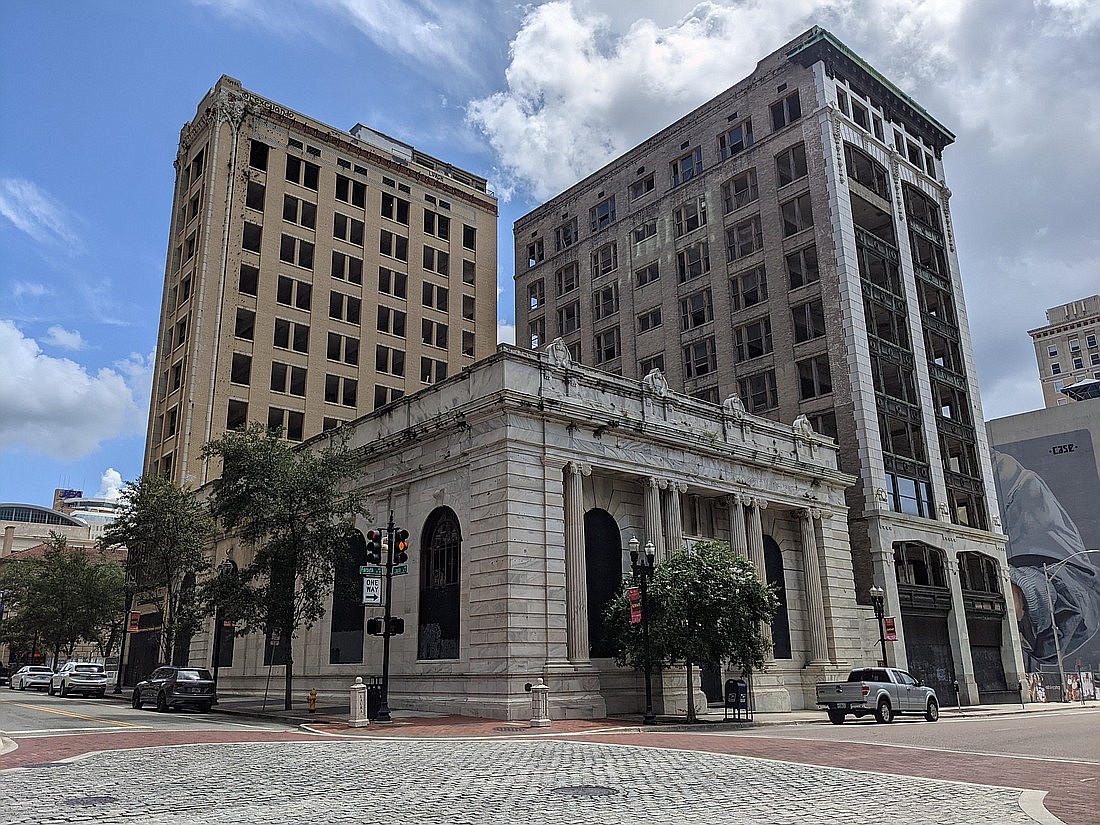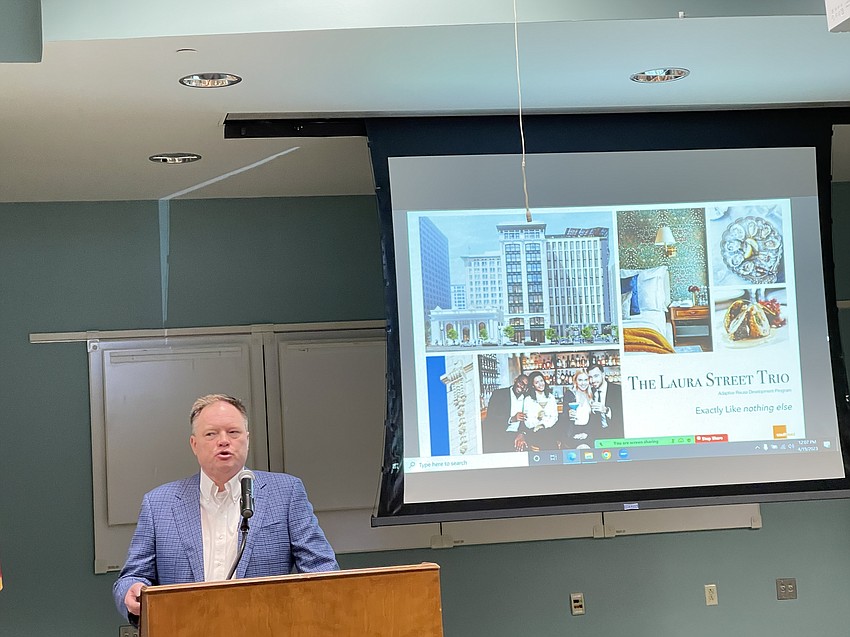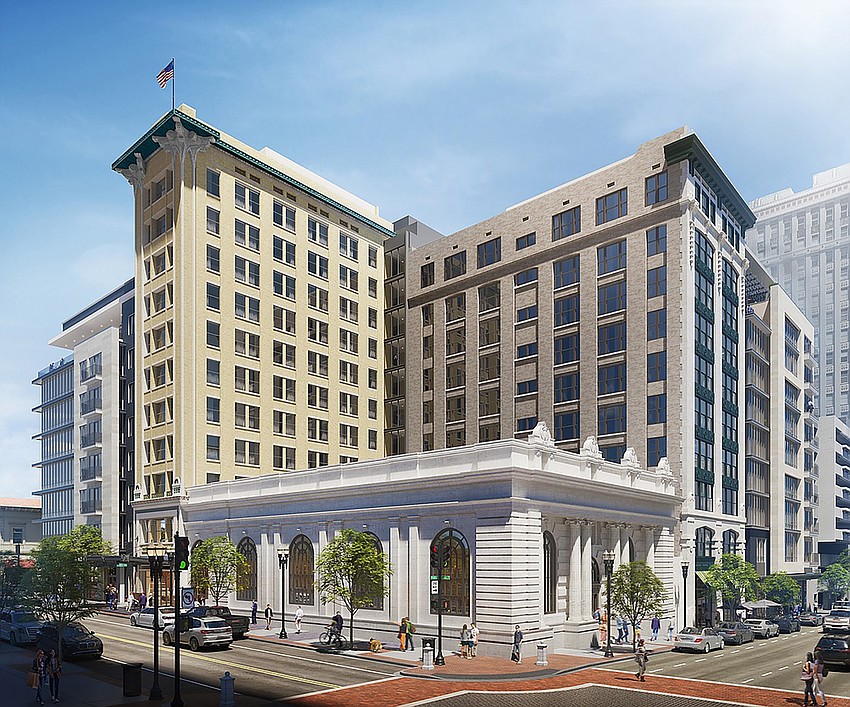
As developers of a proposal to revive the Laura Street Trio prepared to head back down a well-worn path to the negotiating table with the city, the leader of the project made headlines by saying the only feasible way forward may be to wipe the historic buildings off of the property and start on fresh dirt.
Steve Atkins, principal of the SouthEast Development Group, mentioned demolition as an option after a Jan. 4 vote by the Jacksonville City Council to send SouthEast’s latest request for city-backed incentives to the Downtown Investment Authority for further review and negotiation of new terms.

Atkins received incentives for the project twice before, but construction plans fizzled both times. After SouthEast’s new request stalled at the Council meeting and was shipped over to the DIA, Atkins said it was becoming increasingly difficult to fashion a financially viable deal to revitalize the Trio buildings as part of a new development on the site.
The buildings, constructed between 1902 and 1912, have been vacant for 30-plus years, and Atkins said razing them in favor of new construction could be his only option.
But there’s more to the Trio’s fate than whether SouthEast and the DIA can work out a new deal, because the buildings are cocooned in historic protections that will make it difficult to bring them down.

Alan Bliss, CEO of the Jacksonville Historical Society, said the three buildings are protected under two separate classifications: They have been designated as local historic landmarks and are listed as contributing structures within the federally designated Downtown Jacksonville Historic District.
Factors behind the protections include the buildings being among the first built after the 1901 fire that destroyed much of Downtown, and two being designed by noted Jacksonville architect Henry J. Klutho.
Bliss said a demolition permit for any of the buildings would automatically be subject to review by the city Historic Preservation Commission, which would need to issue a certificate of appropriateness to raze the structures.
If the commission signed off on demolition, its decision would be reviewed by the Council Land Use and Zoning Committee and, if approved there, would be subject to a vote by the full Council.
Advancing a demolition permit to the Council would be highly unlikely, Bliss said. And judging by Council members’ comments about the Trio during the Jan. 4 meeting, pushing it over the final hurdle might be more difficult.
Nearly to a person, the 13 Council members in attendance expressed support for redeveloping the Trio.

“I agree with Mr. Atkins’ team that these three historic buildings need to be restored,” Council member Nick Howland said. “I’d love to see the Laura Street Trio thrive.”
However, Howland said, the current incentives package wasn’t the right vehicle for reviving the buildings. His colleagues agreed, and sent the deal to the DIA for more work.
That decision came during what was originally supposed to be the first of two full Council meetings aimed at fast-tracking the incentives. Instead the lead sponsor of an ordinance containing the incentives, Council member Matt Carlucci, withdrew it from emergency consideration, and Council President Ron Salem canceled the second of the two hearings.
As outlined in Ordinance 2023-876, the city’s incentives would include $36.5 million in forgivable loans and property tax breaks, a $2 million forgivable loan and a $22 million “city participation loan” designed to guarantee a 25-year construction loan obtained by Atkins from Capital One Public Funding.
The city funding would be placed in a reserve and used as a backstop – it would only be paid out if Atkins defaulted on the construction loan.
In return, the city would earn 12% of net cash flows from the completed property until the loan is satisfied and would receive 5% of net profits from either a sale or refinancing of the property.
With the funding, SouthEast proposed to revive the buildings and construct two new towers that together would comprise 300,000 square feet.
The complex would include a Marriott Autograph Collection hotel, 169 multifamily units with 30% leased as workforce housing, 6,500 square feet of retail space, a rooftop bar, an underground speakeasy and restaurants.
But the deal drew a barrage of concerns from top city and DIA administrators, who described it as being rife with potential pitfalls for the city.
Among them: It could violate restrictions in the state constitution on cities lending money; would subject the city to as much as $432 million in debt liability; could trigger a downgrading of the city’s credit rating; and could require the city to submit to highly favorable terms for Capital One.
Atkins said Capital One was seeking to close on the construction loan in January, which was the basis for Carlucci seeking passage of the ordinance on an emergency basis.
SouthEast Development Group attorney Jason Gabriel told Council members the “replenishment guarantee” in the agreement – the $22 million city backstop – was being renegotiated to address the types of concerns mentioned by administrators.
“It will be clarified, revised and made consistent,” he said.
Other members of the group rebutted the staff’s concerns about indebtedness and other issues. For instance, SouthEast partner Graham White argued that credit-rating agencies would react well to the deal because “you can actually look at this as a profit center” that would generate $50 million or more for the city.
Council members described the deal as being premature for Council consideration and being too favorable to Capital One.
“My question is, why rush it?” Council member Rahman Johnson said. “Let’s get the right ingredients, let’s bake the cake and make it something the entire city can be proud of.”
Council member Ken Amaro said the proposal was “almost as if we’re being asked to write a blank check.”
“And if we start here, we might as well do it for every other developer who comes along.”

Carlucci agreed that the proposal needed more work, but decried negativity surrounding the issue.
“Damn it, let’s find a way to make this happen, and let’s not keep finding and parading the damn horribles,” he said during the meeting, referring to complaints.
“Let’s have a can-do attitude and put the horribles aside.”
Recognizing the complexity of the proposal, the Council gave the DIA leeway to negotiate beyond the guidelines it usually uses in determining whether incentives are justified by a project’s return on investment in terms of increased property value and economic impact.
That leeway could be significant, given how the DIA board landed on an earlier version of the incentives in mid-2023.
The board voted to send a portion of that $63 million incentives package to the Council with neither a recommendation for nor against passing it.
The reason: The incentive didn’t meet the DIA’s guidelines, but the board didn’t want to reject it and put the redevelopment in jeopardy.
At the time, DIA CEO Lori Boyer described the board’s action as a “bunt” to the Council to keep the project in play.
With a new round of negotiations beginning, the question is whether the DIA and SouthEast can forge a more traditional incentives package versus one that relies on a city participation loan.
Meanwhile the Trio continues to sit, which concerns Bliss. The more time that passes without a deal, he said, the more difficult and expensive it will be to save the buildings.
The complications involved in restoring old buildings, such as sourcing materials and finding construction workers with specialized skills in restoration, grow as structures age and deteriorate.
Eventually, he said, depreciation erodes a project’s economic viability.